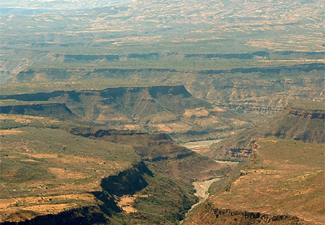Researchers use remote sensing technology to go back in time on the Ethiopian Plateau
Posted by news
The cliffs that rise above the Blue Nile contain 750 million years of exposed geologic history. But it’s what’s happened in the past 6 million years that intrigues Dr. Mohamed Abdelsalam, an associate professor of geology at the University of Missouri-Rolla, and his research colleagues.
The group’s findings about the rates at which geologic material has been removed from the Ethiopian Plateau are published as the cover story in September’s GSA Today, a publication of the Geological Society of America.
 |
| The cliffs that rise above the Blue Nile contain 750 million years of exposed geologic history. Remote sensing technology shows that dramatic geologic changes started to take place about 6 million years ago. |
In addition to satellite images, Abdelsalam and the other researchers relied on data from a Space Shuttle Endeavour flight in 2000. By employing new 3-D technology, the group was able to trace the evolution of the Gorge of the Nile back in time about 30 million years. They discovered that, as the Ethiopian Plateau was uplifted, the river began to flow with increased power.
According to the researchers, the most dramatic geologic changes started happening in the Gorge of the Nile approximately 6 million years ago.
In the meantime, East Africa changed relatively quickly from a woodland to a savanna to a largely arid region. These evolving geologic conditions likely corresponded with big changes in early human evolution.
According to Abdelsalam, Charles Darwin concluded that human evolution was a consequence of adaptive change on the African Savanna.
“And we can now show a connection between the rates of geologic evolution and human evolution,” says Abdelsalam, who conducts his work in UMR’s new 3-D Visualization and Remote Sensing Laboratory. “This is an exciting outcome that can result in future multi-disciplinary research.”